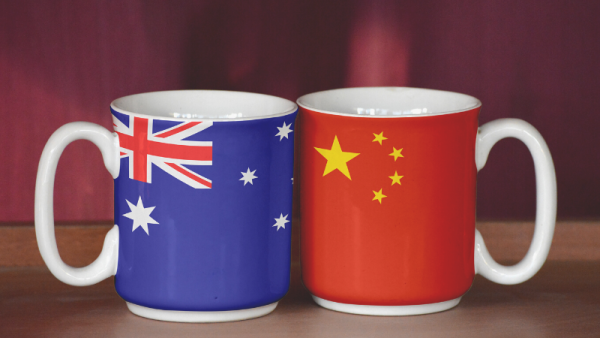Aritra Deb / Shutterstock

James Laurenceson, Director, Australia-China Relations Institute, University of Technology Sydney |
Perspectives is UTS:ACRI's monthly commentary series, featuring a piece on a topical subject in the Australia-China relationship from an invited expert contributor.
In plotting Australia’s approach to managing relations with the People’s Republic of China (PRC) in the decade ahead, it is important to be ‘clear-eyed about the China that is, rather than the China we wish’.
The next step is to be clear-eyed about our policy options in response, drawing on those most likely to be effective, rather than those that just make us feel justified and plucky.
A case in point: has Australia’s national interest been served by intelligence agencies raiding the homes of four PRC journalists accredited to state media in an application of foreign interference laws? Or by declaring two mainland Chinese academics who were directors of the two largest and most active Australian Studies Centres in the PRC as security risks and revoking their visas as part of the same investigation?
It remains an open question but there are reasons to be concerned.
On May 25 2017, Duncan Lewis, then-Australian Security Intelligence Organisation (ASIO) Director-General, put on the public record that foreign interference was occurring ‘on an unprecedented scale, and this has the potential to cause serious harm to the nation's sovereignty, the integrity of our political system, our national security capabilities, our economy and other interests’.
This served as the trigger for the enactment of foreign interference laws in June the following year.
Once on the books, it was entirely predictable that the Minister for Home Affairs and the agencies themselves would feel intense pressure to deliver ‘scalps’.
On November 18 last year, Peter Hartcher, International and Political Editor of The Sydney Morning Herald wondered, ‘[W]hy are the foreign influence laws not being enforced?’. He went on to opine, ‘It is worse than pointless for parliaments to pass fine laws, for politicians to make grand speeches, if the laws are not enforced’.
The next month, Hartcher followed up by contending, ‘The authoritarian great power, China, was mocking the laws that the Parliament passed a year and a half ago’. Reacting to news that Prime Minister Scott Morrison had announced the formation of a taskforce to enhance enforcement capabilities, he prodded harder, ‘Congratulations, Prime Minister. But does your government have the political will to follow through in the implementation?...[a] test of actual enforcement will be whether we see arrests, prosecutions, deportations of people…’
When news broke in June this year that the home of New South Wales MLC, Shaoquett Moselmane had been raided in connection to a foreign interference investigation, Peter Jennings, the head of the Australian Strategic Policy Institute, told The New York Times, ‘From the moment the new legislation appeared, I anticipated that our intelligence agencies would be looking for a case to test the laws out on’.
Indeed. But that also drew attention to a problem. Intelligence agencies may have incontrovertible evidence that Moselmane was a target of foreign interference. But what also seems incontrovertible is that his ability to influence political decisions in Australia in ways favourable to Beijing was marginal to non-existent.
The professionalism of intelligence agencies is not the principal issue here. Answering the question of whether the benefits outweigh the costs of using intelligence and legal means to push back against PRC government interference is one that only political leaders can make.
This will likely be a long march. And what is on the public record to date does not inspire confidence that preserving Australian sovereignty is the sole factor that will drive their application, or that the full suite of consequences of doing so are being contemplated.
Last month, when asked to confirm reports in PRC state media that ASIO had raided the homes of journalists for PRC state media alongside Moselmane’s, Home Affairs Minister Peter Dutton insisted, ‘I’m not going to comment in relation to that’. Yet a few months earlier Minister Dutton had raised no operational security concerns when a Melbourne-based journalist was in position to film the dawn raids on Moselmane’s Sydney property.
And when it became public knowledge that Anthony Byrne, deputy chair of the Australian parliament’s intelligence committee, had boasted of being able to work with journalists to orchestrate a ‘hatchet job on China’, Minister Dutton’s response was simply, ‘I think he has done a great job in the intelligence committee’.
(Recall also that it was Minister Dutton’s comments fresh from a visit to Washington in April that appeared to confirm in the PRC government’s mind that Australia’s call for an independent, international inquiry into the origins and global spread of COVID-19 was at the behest of the US.)
Actions taken in pursuit of foreign interference laws have contributed to there now being no Australian media outlets with journalists on the ground in the PRC, as well as bilateral academic exchanges being curtailed. Heightened risks for Australian businesses engaging with the PRC are another outcome.
Australia’s democratic institutions, notably a free and independent media, were already achieving results against foreign interference by shining a light on it. The Morrison government also proved adept in seizing other opportunities such as working with universities to ensure that their activities did not work against Australian interests.
For Australians facing intimidation and harassment by Beijing for exercising their right to free speech, legal remedies may well be part of the necessary mix in pushing back.
But it is also a hideous prospect that because Australia now has foreign interference laws, incentives are such that resources will be poured into justifying their existence and political fancies rather than security realities will feature in their use.
Meanwhile, there is no off-ramp to tensions in the Australia-PRC relationship in sight.
Author
Professor James Laurenceson is Director of the Australia-China Relations Institute at the University of Technology Sydney.


